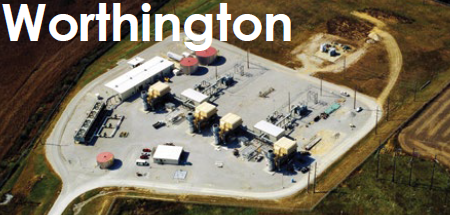
Worthington Generating Station
Owned by Hoosier Energy Rural Electric Co-op Inc
Operated by NAES Corp
174 MW, four simple-cycle LM6000 natural-gas-fired peaking units, located in Greene County, Ind, and connected to Hoosier’s 138-kV transmission line
Plant manager: Robert VanDenburgh
Challenge. Hoosier Energy’s Worthington Generating Station relies on four 1800-ton chillers during summer peak operations to provide 40F water to the air inlet houses of its four LM6000s, thereby ensuring top gas-turbine performance.
To protect against freeze-up during the winter, 40% glycol is added to the chilled-water loop; a small boiler maintains loop temperature at 54F. The warm glycol/water mixture circulates through the inlet coils, heating inlet air to maintain the optimal temperature for efficient generation.
Periodic coil inspections required removal of the upper panels on the filter house which can be accomplished only from the top of the structure. This dictated an aerial lift and fall protection. The aerial lift created a safety hazard and fall protection increased the time required to complete inspections.
Among the challenges facing plant personnel were the following:
- How to eliminate the need for an aerial lift.
- How to engineer out the need for fall protection.
- How to remove the access panels without need for a pry bar.
- How to decrease the amount of time needed to complete coil inspections.
Solution. The operations team concluded that the safest way to access the coils was to install a fixed ladder to the top of the filter house (photos). The team also decided to install a guardrail on top of the filter house package to remove the fall hazard. Plus, handles were installed on each of the four coil cover plates to eliminate the need for a pry bar. The handles eliminate pinch points and hand traps which will allow the technician to remove the coil plates with increased safety and greater ease.

Results. By installing ladders and guardrails, the fall hazard associated with the coil inspections has been eliminated. Plus, the amount of time needed to perform inspections also has been reduced.
Because many inspections are conducted during cold weather conditions, minimizing exposure to the elements also created a safer work environment. Installing handles to the coil access plates completely eliminated pinch points and hand traps, adding another layer of safety to this task.
Plant personnel created a much safer work environment while reducing the time needed to complete inspections. The safety improvements have enabled an increase in inspection intervals, thereby boosting gas-turbine performance.
Project participants:
Matthew O’Hara, lead O&M technician
Jason Robertson and William Hooker, plant operators


